CTV ATLANTIC: RICHARD AND TODD BATTIS ON NEW MOVIES IN THEATRES!
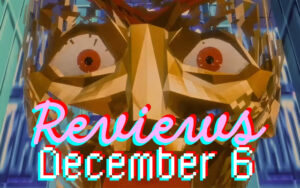 I join CTV Atlantic anchor Todd Battis to talk about the almost epic “The Return,” the apocalyptic musical “The End” and the nostalgic disaster flick “Y2K.”
I join CTV Atlantic anchor Todd Battis to talk about the almost epic “The Return,” the apocalyptic musical “The End” and the nostalgic disaster flick “Y2K.”
Watch the whole thing HERE!
 I join CTV Atlantic anchor Todd Battis to talk about the almost epic “The Return,” the apocalyptic musical “The End” and the nostalgic disaster flick “Y2K.”
I join CTV Atlantic anchor Todd Battis to talk about the almost epic “The Return,” the apocalyptic musical “The End” and the nostalgic disaster flick “Y2K.”
Watch the whole thing HERE!
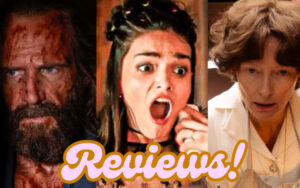 I sit in on the CFRA Ottawa morning show with guest host Andrew Pinsent to talk the new movies coming to theatres including the almost epic “The Return,” the apocalyptic musical “The End” and the nostalgic disaster flick “Y2K.”
I sit in on the CFRA Ottawa morning show with guest host Andrew Pinsent to talk the new movies coming to theatres including the almost epic “The Return,” the apocalyptic musical “The End” and the nostalgic disaster flick “Y2K.”
Listen to the whole thing HERE!
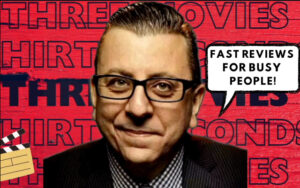 Fast reviews for busy people! Watch as I review three movies in less time than it takes to do a high five! Have a look as I race against the clock to tell you about almost epic “The Return,” the apocalyptic musical “The End” and the nostalgic disaster flick “Y2K.”
Fast reviews for busy people! Watch as I review three movies in less time than it takes to do a high five! Have a look as I race against the clock to tell you about almost epic “The Return,” the apocalyptic musical “The End” and the nostalgic disaster flick “Y2K.”
Watch the whole thing HERE!
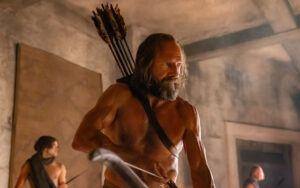 SYNOPSIS: Taking its inspiration from an ancient text, “The Return,” a new historical drama starring Ralph Fiennes and Juliette Binoche now playing in theatres, is the story of a disgraced king returning from the disastrous Trojan War.
SYNOPSIS: Taking its inspiration from an ancient text, “The Return,” a new historical drama starring Ralph Fiennes and Juliette Binoche now playing in theatres, is the story of a disgraced king returning from the disastrous Trojan War.
CAST: Ralph Fiennes, Juliette Binoche, Charlie Plummer. Directed by Uberto Pasolini based on Homer’s Odyssey.
REVIEW: A story of loyalty and vengeance, “The Return” is a stripped-down version of the Greek poem “Homer’s Odyssey.” Epic in its themes if not in its execution, the story derives much of its power from the performances of Ralph Fiennes and Juliette Binoche as lovers separated by the ravages of war and time.
Director Uberto Pasolini, who co-wrote the script with John Collee and Edward Bond, skips past the more fanciful parts of Homer’s poem. There’s no cyclops, divine intervention or multi-headed monsters. Instead, it skips to Odysseus (Ralph Fiennes), the legendary Greek king of Ithaca, returning home after twenty years at war. Assumed dead, unrecognizable and mistaken for a beggar, he finds his former kingdom in disarray.
His wife Penelope (Binoche) never remarried, despite the dozens of suitors who vied for her hand. As she is pressured to choose a husband to take the throne, her son Telemachus (Charlie Plummer) is threatened with death by ambitious wannabe-kings.
Before he can return home to his wife, son and throne, Odysseus must come to grips with his past as a warrior responsible for his vanquished army. “What will the people say when they see I have returned alone?” he asks. “That I led all their men to their deaths.”
Fiennes embraces this more earthbound adaptation. His Odysseus is a man beaten by war, scarred mentally and physically. “It’s everywhere,” he says of war. “It’s in everything you touch.” Just as the movie is stripped down, so is his performance. Divested of the formality and archaic language that frequently comes along with adaptations of ancient stories, “The Return” allows Fiennes to concentrate on what fundamentally makes the character interesting, his humanity.
Weary from war, he is defeated, but we still get a sense of the warrior he once was and the guile that helped him survive. It’s a terrific performance that showcases the character’s duality, at once sorrowful and frail and yet, able to muster the power that made him a king.
And, at age 61, Fiennes is ripped, sinewy and shredded, as revealed by his loose-fitting toga and a full-frontal nude scene.
Binoche is regal, displaying the kind of dualism that makes Fiennes’s Odysseus so compelling. She’s mournful at the loss of her husband, the wreck her kingdom has become and the political maneuvering that threatens the life of her son. And yet, she persists, using her wits to control the situation.
“The Return” is not a spectacle by any means. The sets and wardrobe are kept to a minimum, but the simplicity works, bringing focus to a story that could easily have been distracted by flashier design or a load of CGI.
“The Return’s” slow-ish pace and conversations with more pauses than dialogue may take some getting used to, but they are all in service of building tension, which eventually explodes in the film’s fiery climax.
There will be some debate as to whether or not “High Life,” a new space opera from director Claire Denis, can be classified as sci fi or not. It takes place on a starship, is set in the outer reaches of the solar system and features other sci fi faves like black holes and space stations but the setting almost takes a back seat to the very earth-bound humanity on display.
Robert Pattinson plays Monte, one of a group of death row convicts sent on a suicide mission to deep space aboard a space station. When we first meet Monte he’s alone save for his infant daughter Willow (Scarlett Lindsey). Soon, via flashbacks, we learn more about the situation, the social breakdown with the other passengers and Dibs (Juliette Binoche), the supervising doctor who performs sexual experiments on the crew, as the space station hurtles toward the abyss of a giant black hole.
There are certainly sci fi aspects to “High Life” but all the molecular clouds and the spacey instances of spaghettification (look it up), etc are trumped by, I want to say drama, but that’s not quite accurate. There isn’t much drama to be milked from a story where the characters are in lock down with little or no room for growth. There are some good performances here, particularly from Pattinson as a man who survives through discipline, and Binoche whose cold, clinical obsession to create new life borders on the sadistic, but the film is more about creating atmosphere than forming dramatic moments.
Denis is unafraid to linger on a moment, to allow the incremental passing of time aboard the ship to be reflected in the film’s pacing. Sometimes it works, offering a glimpse into the mundane lives of people for whom there is no future, but often it feels as though time has stood still and not in a good way. Add to that pages of whispered expository dialogue and you’re left with a film that maintains a sense of hope that Monte and Willow will be OK but doesn’t give us much of a reason to care what happens to them.
Can you steal someone’s life? It’s the question at the heart of “Ghost in the Shell,” in more ways than one.
Based on the Japanese manga of the same name by Masamune Shirow, it centers around a woman, played by Scarlett Johansson, rescued by scientists at AI robots manufacturer Hanka Robotics and turned into a weaponized cyber-human. “Your body was damaged,” says Dr. Ouelet (Juliette Binoche). “We couldn’t save it, only your brain survived.” Named The Major (more on that later) after her cerebral salvage she leads task force Section 9 who take down cyber terrorists and hackers by any means necessary. “We saved you,” continues Dr. Ouelet, “and now you save others.” The life the Major once knew is over but as the doctor says, “Your mind, your soul and your ghost, that’s still in there.”
On another level “The Ghost in the Shell” steals away the essence of itskmain character. The Major, or Major Motoko Kusanagi as she was referred to in the 1989 manga series and beyond, is a Japanese character in this case being played by the very western Johansson. Director Rupert Sanders dismisses the whitewashing criticism saying, “I feel that [Johansson] channelled the Major better than anyone else I could have thought of. She was my first choice and remains my first choice. She’s the best actress of my generation and her generation and the person I felt most embodied the physicality and the ability to inhabit that role.”
I think Sanders forgot to insert the word “bankable” in there somewhere.
I’m not suggesting that Johansson isn’t a talented actor or capable of pulling off believable and exciting action scenes. In movies like “Lucy” and “Captain America: Civil War” she has credibly occupied the action space, bringing both toughness and acting chops to her roles. That’s not at issue. What is at issue here is that the character is decidedly Japanese. As a human brain in an entirely synthetic body, she is far from, as Johansson claims, “identity-less.” In fact she is the very embodiment of a culture’s fascination with technology and how that technology interacts with humankind. In this case the technology actually becomes human, or perhaps it’s the other way round. Either way, the cyberpunk heroine is a key figure in Asian science fiction and the new “Ghost in the Shell” conveniently ignores that fact.
More thought has been put into creating the world The Major interacts with. A mix of the original anime, “Minority Report,” and “Robocop” with a taste of “Blade Runner” and “The Matrix” thrown in for completists, it’s a sleek near future environment, dense with activity, like in New York City and Hong Kong had a baby.
It is also a place where it’s now possible to control people by hacking directly into their minds. To combat this invasion of the mind, the Major and Co. have their sights set on Kuze (Michael Carmen Pitt), a shadowy cyber terrorist who is targeting Hanka scientists. Complicating the mission are nagging memories of The Major’s former life that manifest themselves through a glitch in her wiring. She sees strange visions, sort of sensory echoes that hint at memories just out of reach. They are the ghost in the shell. She’s sort of like a high tech Jason Bourne, deadly with little recall of the past. “Who are you?” asks a woman who may or may not be The Major’s mother. “I don’t know,” Maj says with a faraway look.
To get to the bottom of the artificial intelligence technology conspiracy that landed her with Handa Robotics, The Major goes rogue. “They created me,” she says, “but they cannot control me.”
One of the most popular Japanese animated series of all time, “Ghost in the Shell” is a beautiful looking movie, which, like its main character, is in search of its soul. Director Rupert Sanders has an extraordinary eye, whether he is visualizing the hacking of The Major’s mind, creating a nightmarish nightclub sequence or bringing surreal cityscapes complete with video statues and future world architecture to vivid life. The movie is never less that entertaining for the eye, passing the time in a wild swirl of colour and movement.
It’s a shame the story isn’t as entertaining. Filtered through a Hollywood lens, what was once a seminal work of cyber punk is reduced to a superhero origin story with action scenes aplenty. Most are beautifully staged even though the odd shot feels like out takes from an upcoming Black Widow spin off.
Johansson pulls off the cold efficiency of a machine tempered with emerging human feelings. She’s a killing machine but never more human than when she explores what it feels like to be flesh and blood, not synthetics and wires. Its territory she’s tread before, most notably and more effectively in “Under the Skin” but it’s an otherworldliness that suits the role.
Binoche as the empathetic AI specialist and mother figure is terrific and the legendary ‘Beat’ Takeshi Kitano isn’t given much to do, but does it with aplomb.
“Ghost in the Shell” is a gorgeous looking film that will engage the eye but not the brain.
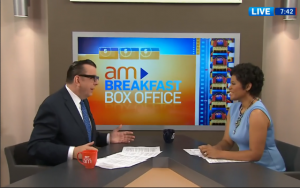 Richard’s “Canada AM” reviews for “The Longest Ride,” “Danny Collins,” “The Clouds of Sils Maria” and “Cut Bank.”
Richard’s “Canada AM” reviews for “The Longest Ride,” “Danny Collins,” “The Clouds of Sils Maria” and “Cut Bank.”
Watch the whole thing HERE!
“The Clouds of Sils Maria” contains fine performances from its leads, Juliette Binoche, Kristen Stewart and Chloë Grace Moretz, some delicious irony, and some razor sharp commentary on the state of modern celebrity. What it’s missing is entertainment value.
French director Olivier Assayas has made an art house “Birdman,” with stunt casting but allows it to get weighed down by its ideas and melodrama.
Binoche is actress Maria Enders, an international star who got her start decades ago on stage playing the alluring Sigrid in “Maloja Snake,” a young woman who drove her boss Helena to suicide. When she is offered the role of the older woman in an all-star remounting of the play opposite Jo-Anne Ellis (Moretz), a scandal-prone Hollywood starlet, she retreats to the relative calm of Sils Maria, a rural town in the Alps, to rehearse with her assistant Val (Stewart) while contemplating aging, her past and her place in show business.
“The Clouds of Sils Maria” is as self absorbed as the people it portrays. The most interesting tangents, from a pop culture point of view, concern the character Val, who seems to be piercing the fourth wall by allowing Stewart to seemingly comment on her “Twilight” success and subsequent career. “I love her,” she says of Ellis, “she not completely antiseptic like the rest of Hollywood.” In fact, it’s more likely she’s referring to herself and her descent from Tween Queen to serious working actor.
“Clouds” is very much Binoche’s film—she’s in almost every scene and the action revolves around her—but thematically it’s not a stretch to see it as Stewart’s comment on her own career. “She’s brave enough to be herself,” Val says admiringly of Ellis, throwing down the gauntlet to critics who might questions her less than mainstream choices of late.
As interesting as that glimpse into Stewarts ID may be coupled with Maria’s fears of losing credibility, “The Clouds of Sils Maria’s” art vs. life premise takes pains to make the discovery of these points as obtuse as possible. Plot shards hang, interrupted by jarring scene transitions and needless narrative machinations. It’s the rare kind of movie that is undone by the very same cultural elitism it celebrates.
Conspiracy theorists are going to love the new “Godzilla” film.
In this big-budget reboot of the giant lizard series “Breaking Bad’s” Bryan Cranston plays Joe Brody, head of a nuclear facility in Tokyo. When something triggers a massive meltdown at the facility tragedy, both professional and personal strikes.
Fifteen years later Brody is living on the fringes, still obsessed with the accident that changed his life.
The army, the government and mainstream media wrote off the incident as a nuclear meltdown caused by earthquakes, but Brody is convinced it wasn’t Mother Nature but something more nefarious.
When he is arrested for trespassing on the accident site his son, Ford (Aaron Taylor-Johnson), a military bomb expert on leave in the United States, travels to Japan to bail him out and bring him back to San Francisco.
Before father and son can head west Brody Sr’s wild theories are proven correct. He was right that it something other than earthquakes and tsunamis responsible for the breakdown fifteen years previous. That “something” turns out to be a Massive Unidentified Terrestrial Organism (or MUTO), a giant winged creature that feeds off earth’s natural radiation.
Unfortunately by the time his theories are validated the MUTOs have begun to wreak havoc and there is only one force on earth (or maybe just under the earth) powerful enough to battle the overgrown mosquitoes—Godzilla, king of the monsters.
In a movie like this you know that when Ford’s wife says, “You know you’re only going to be away for a few days… it’s not the end of the world,” that he’ll be gone for more than a few days and it just might be the end of the world, or something pretty close to it.
“Godzilla” plays by most of the rules of the giant lizard genre, but stomps all over 1998’s Roland Emmerich by-the-book remake. The standard kaiju kitsch is all in place—humungous monsters knock skyscrapers over with the flick of a tail and scientists talk mumbo jumbo—but director Gareth Edwards has added in some moments of real heartbreak, small sequences that underscore the huge amount of destruction the creatures cause.
Cranston hands in a dialed-up-to-eleven performance that occasionally feels like it might have worked better in Emmerich film, but supporting roles from Ken Watanabe, Sally Hawkins, Elizabeth Olsen and Taylor-Johnson are more modulated.
But who cares about the humans? They are merely the meat props that set the stage for what we’re really paying to see—the showdown between Godzilla and the MUTOs.
For the most part creature feature fans will be pleased. The MUTOs are malevolent spider-like beasts with scythe arms, a bad attitude, and worse, a need to reproduce. Godzilla is a towering figure with nasty looking spikes spouting from his back and tail, like a row of jagged mountains no man or monster will ever be able to cross.
The MUTOs are on full display, but if I have a complaint it’s that Godzilla doesn’t enter until a bit too late in the game. This whole “Cloverfield” don’t-show-the-monster thing is artistically noble, but if I wanted to NOT see Godzilla I’d go see “Million Dollar Arm” instead. For much of the movie every time we get to the cool ‘Zilla action, Edwards cuts to something else or shrouds him behind a cloud of soot and smoke. He is, as Sally Hawkins’ character says, “a God for all intents and purposes,” so we should be treated to a better look at him.
Perhaps a little Godzilla goes a long way for some, but the monster fanboy in me was greedy for more. The battle scenes, however, are top notch, shot from shifting points of view to give you the full experience of Godzilla’s awesome presence.
“Godzilla” plays like “Jurassic Park” times two, the thrills have been amped up but Edwards has managed to maintain the spirit of the original “Godzilla” movies while updating them for a new audience.